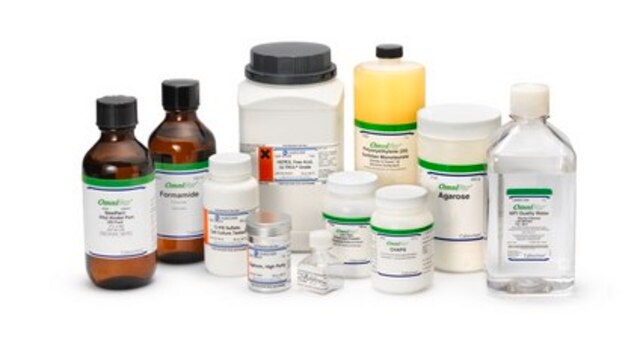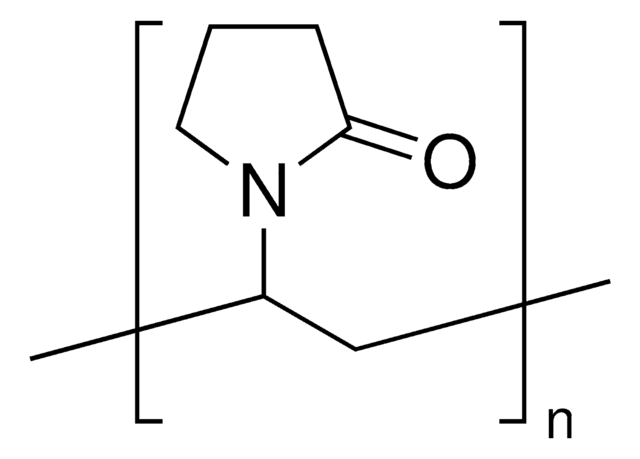PVP10
Polivinilpirrolidona
average mol wt 10,000
Sinônimo(s):
PVP, Polividona, Povidona
Faça loginpara ver os preços organizacionais e de contrato
About This Item
Fórmula linear:
(C6H9NO)n
Número CAS:
Número MDL:
Código UNSPSC:
12352100
ID de substância PubChem:
NACRES:
NA.21
Produtos recomendados
Formulário
powder
Nível de qualidade
peso molecular
average mol wt 10,000
número de viscosidade
12-18(lit.)
cadeia de caracteres SMILES
C=CN1CCCC1=O
InChI
1S/C6H9NO/c1-2-7-5-3-4-6(7)8/h2H,1,3-5H2
chave InChI
WHNWPMSKXPGLAX-UHFFFAOYSA-N
Procurando produtos similares? Visita Guia de comparação de produtos
Descrição geral
Polyvinylpyrrolidone (polyvidone, povidone, or PVP) is a synthetic water-soluble polymer consisting of linear 1-vinyl-2-pyrrolidinone groups. It is hygroscopic and readily absorbs up to 40% of water by its weight. It has excellent wetting properties in solution and easily forms films, which makes it suitable for use as a coating additive.PVP can be synthesized from its monomer N-vinylpyrrolidone via free-radical polymerization in the presence of AIBN as an initiator. In chemical industries, PVP is widely used as a surface stabilizer, growth modifier, nanoparticle dispersant, and reducing agent.
PVP can serve as a surface stabilizer, nanoparticle dispersant, growth modifier, and reducing agent, depending on the synthetic conditions.
PVP can serve as a surface stabilizer, nanoparticle dispersant, growth modifier, and reducing agent, depending on the synthetic conditions.
Aplicação
PVP (average mol wt 10,000) can be used as a stabilizing agent in the synthesis of metal nanoparticles to prevent them from agglomeration. PVP is also used in the fabrication of mesoporous silica-polymer hybrid (PVP-aminopropyl-SBA-15 Schiff Base hybrid) for the effective removal of divalent heavy metal cations from wastewater. Grafting of PVP functionalization offers a strong affinity for heavy metal ions because it provides two adsorption sites, one through metal-C-O group interaction and the other through metal-π interaction (the chelation of with Schiff base).
Outras notas
A polivinilpirrolidona é um componente da solução de Denhardt e está incluída a uma concentração de 1% (p/v) na solução-estoque 50X padrão.
Código de classe de armazenamento
11 - Combustible Solids
Classe de risco de água (WGK)
WGK 1
Ponto de fulgor (°F)
Not applicable
Ponto de fulgor (°C)
Not applicable
Equipamento de proteção individual
Eyeshields, Gloves, type N95 (US)
Escolha uma das versões mais recentes:
Já possui este produto?
Encontre a documentação dos produtos que você adquiriu recentemente na biblioteca de documentos.
Os clientes também visualizaram
Guanghua Luo et al.
International journal of medical sciences, 11(10), 1015-1021 (2014-08-20)
Apolipoprotein M (APOM) has been suggested as a vasculoprotective constituent of high density lipoprotein (HDL), which plays a crucial role behind the mechanism of HDL-mediated anti-atherosclerosis. Previous studies demonstrated that insulin resistance could associate with decreased APOM expressions. In agreement
Adam Healey et al.
Plant methods, 10, 21-21 (2014-07-24)
Next-generation sequencing technologies rely on high quality DNA that is suitable for library preparation followed by sequencing. Some plant species store large amounts of phenolics and polysaccharides within their leaf tissue making genomic DNA extraction difficult. While many DNA extraction
Haifang Yang et al.
Horticulture research, 5, 23-23 (2018-05-08)
Litchi is one of the most important subtropical evergreen fruit trees in southern Asia. Previous studies indicated that high-temperature conditions encourage growth of rudimentary leaves in panicles and suppress flowering. We have demonstrated that methyl viologen dichloride hydrate (MV) and
Zhe Gao et al.
Advanced science (Weinheim, Baden-Wurttemberg, Germany), 7(4), 1901624-1901624 (2020-02-27)
Cryopreservation technology allows long-term banking of biological systems. However, a major challenge to cryopreserving organs remains in the rewarming of large volumes (>3 mL), where mechanical stress and ice formation during convective warming cause severe damage. Nanowarming technology presents a
Kallum M Koczkur et al.
Dalton transactions (Cambridge, England : 2003), 44(41), 17883-17905 (2015-10-06)
Colloidal synthesis offers a route to nanoparticles (NPs) with controlled composition and structural features. This Perspective describes the use of polyvinylpyrrolidone (PVP) to obtain such nanostructures. PVP can serve as a surface stabilizer, growth modifier, nanoparticle dispersant, and reducing agent.
Nossa equipe de cientistas tem experiência em todas as áreas de pesquisa, incluindo Life Sciences, ciência de materiais, síntese química, cromatografia, química analítica e muitas outras.
Entre em contato com a assistência técnica

